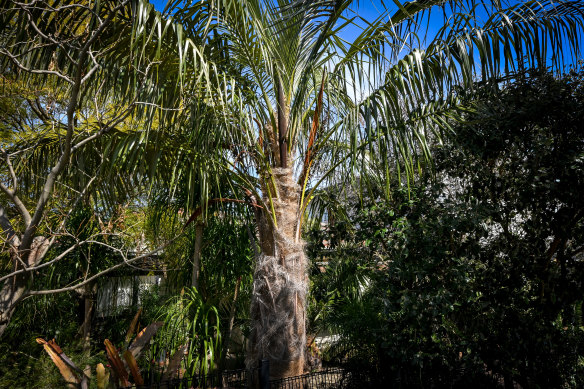While Wilkins does grow relatively commonly seen palms like the Chinese Windmill (Trachycarpus fortunei), European Fan (Chamaerops humilis) and the Kentia (Howea forsteriana), she also has more unusual species, ones that are smaller, softer or with different leaf shapes and colours.
Instead of the big, thorny Pheonix canariensis (Canary island date palm) for example, she has the more diminutive Pheonix rupicola from northern India and the similarly contained Phoenix roebelenii from Laos. She grows a Howea with curly foliage and a Trachycarpus with leaves that have blue-grey undersides.

/Parajubaea cocoides/ from South America doesn’t exist in the wild but is known only from cultivation
Credit:Eddie Jim
Wilkins uses palms at every level, sometimes controlling their shape by removing new clusters of foliage. She says a well-chosen palm can screen overlooking neighbours, by providing foliage at the exact height required while not taking up a lot of room elsewhere, even in the ground. “Palms are more cooperative for that than many things, most palms have compact roots.”
She also says that her palms get by with “minimal watering” in summer and, when it comes to soil care, an annual application of compost and sometimes also of mineral dust.
The trouble is finding some of these palms in nurseries. Like many collectors Wilkins has become involved with online forums and communities, acquiring both seeds and plants from other devotees far and wide. “If I had been confined to asking local nurseries I would have had a limited vision of what is available,” she says.
In response, she has set up a palm broking and consulting business, called Troposhere Gardens, and her work includes advising both botanic gardens and private growers on how they might expand their collections.
When it comes to her taste in palms she says, “I like a great deal of character.” “I have been astonished to discover the incredible diversity of palms. I just think they are really spectacular. They seem to have such a resonance about them.”
They also have great backstories. Point to any palm in Wilkins’ garden and she knows whether it is a 600-year-old Inca cultivar, a hybrid bred for use in temples by Japanese priests or a natural mutation first noticed at a nursery in Sicily.
She has palms endemic to rocky cliffs in Mexico, to limestone ridges in China and to deep canyons in Madagascar. At least 15 of her palms are Australian, including one species that has been growing among rocks and gorges near Alice Springs since it arrived – from Katherine – about 14,000 years ago.
It’s called Livistona mariae and it turns red in summer. It could be good for Christmas.
Wilkins will speak at 7.30pm on October 12 at Burnley. Go to fobg.org.au for more information.
Make the most of your health, relationships, fitness and nutrition with our Live Well newsletter. Get it in your inbox every Monday.
Stay connected with us on social media platform for instant update click here to join our Twitter, & Facebook
We are now on Telegram. Click here to join our channel (@TechiUpdate) and stay updated with the latest Technology headlines.
For all the latest Life Style News Click Here
For the latest news and updates, follow us on Google News.
